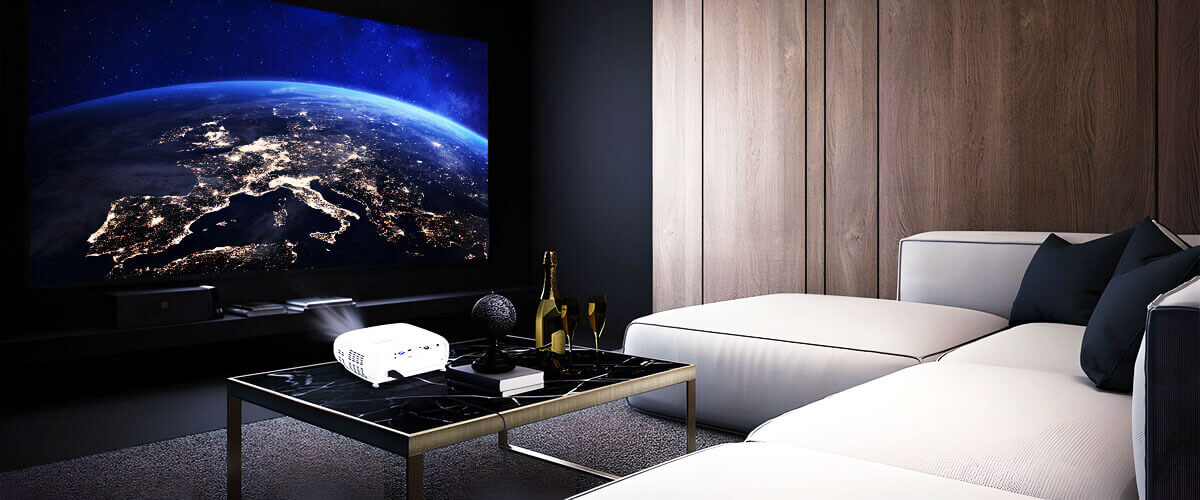Welcome to my review, where I’m about to unravel the world of projectors. Wondering how projectors work? Simply, they’re like magic boxes that take images from your computer or other gadgets and bring them to life on a big screen or any surface you desire. I will explain more clearly and in more detail later in the article.
In this article, I’ll research the inner workings of projectors, explore the various types, and help you pick the perfect one for your unique needs. Let’s not waste time and get started!
The basics of projection

Projection is the art of taking light and using it to recreate images on a much larger scale. It’s like capturing the essence of your screen and magnifying it for everyone to see. But here’s the kicker: the quality of that technology depends on the control of the light source. The more controlled, the crisper and more visible your projected image will be. So, a proper understanding of how light behaves in projection and how a projector works is key to getting the most out of your device.
How digital projectors work

While we all have fond memories of old-school slide and overhead projectors, it’s time to step into the future with different projector types. We won’t be investigating the mechanics of those relics here, as modern devices have taken the stage. Today’s technology is all about digital projectors, and I’m here to break it down for you.
LCD projectors
LCD projectors are like the dependable workhorses of the projection world. They use liquid crystal displays to manage light, delivering vibrant images with incredible precision. For me, it’s like having a mini cinema in the living room.
DLP projectors
DLP projectors, or Digital Light Processing, are the cool kids on the block. They work their magic using a zillion tiny mirrors to create images. Fast, sharp, and perfect for those action-packed movie nights.
LCoS projectors
LCoS (Liquid Crystal on Silicon) projectors combine LCD and DLP technologies. They offer rich colors and high resolutions for a truly immersive viewing experience.
Core components of a projector

Light source
Modern projectors predominantly use LEDs or lasers to cast those vibrant images onto the screen. LED projectors work like reliable workhorses with a decent lifespan and energy efficiency. On the other hand, laser projectors work like wizards, offering even longer lifespans, impeccable color accuracy, and lower power consumption. So, if you’re after vivid colors and efficiency, keep an eye out for laser projectors.
Lenses and mirrors
Next, in the projector anatomy class, we have lenses and mirrors. Lenses are important in capturing and focusing light, ensuring your image stays sharp and clear. Pay attention to those zoom and focus settings, as they can make a difference in your projection. DLP projectors work their charm using tiny mirrors that tilt to manipulate the light and mirrors, alongside lenses, make sure that light travels precisely through the lens.
Image generation
Now, let’s talk about how projectors generate those stunning images. In DLP projectors, the DMD chip is the star. It’s covered in minuscule mirrors that tilt to manipulate the light. Combined with the color wheel, these mirrors create a dazzling array of colors and shades, resulting in vibrant visuals.
On the other hand, LCD projectors use liquid crystals to let light pass or block it pixel by pixel. The colors mix together to form your image. These projectors are known for their sharpness and vividness, making them a solid choice for presentations and home theater setups.
And for the tech-savvy crowd, LCoS projectors combine the greatest of both worlds – reflective technology and liquid crystals – to bring you ultra-high-resolution images.
Image processing and quality

Resolution
Now, when it comes to image quality, resolution is the name of the game. Think of it as the projector’s ability to deliver sharp, detailed visuals. The higher the resolution, the crisper your images and text will appear. Full HD (1920×1080) is a good starting point for most folks, but if you’re a pixel perfectionist, 4K projectors are where it’s at!
Contrast ratio
A good movie or presentation isn’t just about resolution; it’s also about the darks and lights. The contrast ratio is like the yin and yang of projectors. It measures the difference between the darkest and brightest points in an image. A higher ratio means deeper blacks and more vivid whites. Keep an eye out for projectors with higher contrast ratios to make your content pop.
Brightness
Brightness is your projector’s shining personality. It’s measured in lumens, and the more, the merrier, right? Well, not always. The right brightness level depends on your environment. For a dimly lit room, 1500-2000 lumens will suffice, but for battling the sun’s rays in a daytime outdoor event, you’ll want a beast with 3000+ lumens.
Sound accompaniment

Projectors aren’t just about visuals; they handle sound too. Most projectors come with built-in speakers, which are decent for small gatherings. But if you’re looking for a cinematic experience or a booming presentation, consider external audio systems. Remember, perfect audiovisual synchronization is key for an immersive experience, and digital projectors excel at it.
Connectivity and modern features

Input types
Projectors have evolved significantly in recent years. Nowadays, they’re not just about projecting images from your laptop. Projectors work with TVs, smartphones, and other devices seamlessly. Most projectors come equipped with various input options, including HDMI, USB, and VGA, making it a breeze to connect your favorite gadgets. And let’s not forget the game-changing wireless technologies like Miracast and Chromecast. These nifty additions allow for wireless screen mirroring, making customization and flexibility a walk in the park.
Smart projectors
If you’re looking for an all-in-one solution, smart projectors are the way to go. They’re essentially projectors with brains! These clever devices come with integrated systems that enable streaming and support various applications. With a smart projector, you can bid farewell to external streaming devices. It’s a mini multimedia center, perfect for binge-watching your favorite shows or delivering engaging presentations.
Projection software
One notable feature of projection software is keystone correction, which corrects an image to the correct proportions. If you’ve ever set up a projector slightly off-center, you know how distorted the image can appear. Keystone correction software works its magic by adjusting the image to look just right, even when the projector isn’t perfectly aligned with the screen.
Advanced technologies and future trends

3D projection
You’re probably wondering what it takes to bring 3D magic into your life. Well, aside from a 3D-capable projector, you’ll need compatible content (movies, games, or presentations), specialized 3D glasses, and a screen or surface to project onto. These glasses work in tandem with the projector to create an immersive three-dimensional experience. The feeling of objects popping out of the screen is truly mind-blowing.
Interactive projectors
Interactive projectors are a game-changer. Imagine turning any surface into a touchscreen, and you’re halfway there. These projectors use advanced technology to detect your touch or gestures, making them ideal for classrooms and boardrooms. In education, they foster engagement and collaboration, allowing students to interact with lessons. In business, they enhance presentations by enabling real-time annotations and dynamic discussions.
Pico projectors
Pico projectors are the pocket-sized wonders of the projector world, and they’re incredibly portable and versatile, making them perfect for impromptu movie nights or quick business presentations on the go. Pop one in your bag, and you’re ready for spontaneous entertainment or a pitch. However, keep in mind that their small size means limited brightness and resolution compared to their larger counterparts. They’re great for convenience but may not replace your home theater projector.
Applications of projectors

I’m sure you’ll be amazed by how versatile projectors are in real-life applications. From creating your personal home theater (making sure to control ambient light and get the perfect screen size) to spicing up classrooms and boardrooms with interactive and collaborative features, projectors are your tech buddies. But wait, there’s more! Step into the world of public installations and art exhibitions, where these devices transform streets and large spaces with jaw-dropping visuals. And did you know there are even outdoor projectors that work like a charm under the open sky? Projectors aren’t just gadgets; they’re gateways to boundless creativity and engagement!
FAQ
What’s the difference between lumens and watts when it comes to projectors?
Lumens refer to the brightness a projector produces, while watts are a measure of power consumption. In the context of projectors, lumens are paramount. The higher the lumens, the brighter your image will be, making it more suitable for spaces with ambient light. Watts, on the other hand, are about energy efficiency and don’t directly impact brightness. So, when choosing a projector, focus on lumens for a vibrant viewing experience.
How long do projector bulbs last, and how can I tell when it’s time to replace one?
Projector bulbs, or lamps, have a finite lifespan. Typically, they can last anywhere from 2,000 to 10,000 hours, depending on usage and the technology involved. Watch for warning signs like dimming, flickering, or a “replace lamp” message on your projector to know when it’s time for a replacement. You must check your projector’s manual for specific details, as different models vary.
Do I always need a screen to use a projector?
You don’t always need a dedicated screen to use a projector. While screens offer the perfect image quality and consistency, you can project onto surfaces like white walls, light-colored screens, or even a special paint designed for projectors. However, screens help with image sharpness and color accuracy. So, if you’re aiming for a top-notch viewing experience, investing in a good screen is a wise choice. But in a pinch, your living room wall can be a canvas for movie nights!









